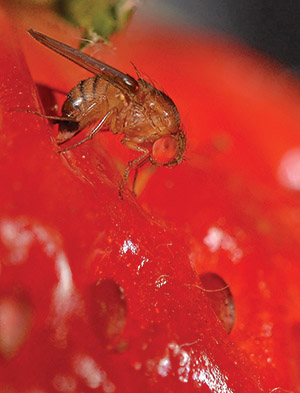
Mediterranean fruit fly and spotted wing drosophila are two insect pests Oxitec is planning to attack using RIDL Photo courtesy of Oxitec
A British biotechnology company is developing a novel new way to control insect pests. Called RIDL, which stands for Release of Insects with Dominant Lethality, it works somewhat like sterile insect releases.
Instead of using radiation to create sterile male insects that mate ineffectively with females, lethal genes inserted into a strain of insects kill the offspring of any females that the altered males mate with.
The company, Oxitec, located in Oxford, England, has applied to authorities in Spain for permission to evaluate its genetically modified olive fly, which could be used to suppress one of Europe’s most damaging insect pests. It has also applied to Brazil to carry out trials on its genetically modified Mediterranean fruit fly.
If approved by Spain, the study would be the first outdoor trial of a genetically modified insect in the European Union, according to Oxitec.
The company is already applying the RIDL technique in Brazil to control mosquitoes that carry dengue fever, and is working on agricultural applications for control of pink bollworm, Mediterranean fruit fly, Mexican fruit fly, spotted wing drosophila, diamondback moth, and tomato leafminer. The technology could be used against other pests that affect fruit crops—codling moth, oriental fruit moth, and many others.
“We are applying this approach in a number of insect pests besides the olive fly and are at various stages of developing the technology in other species,” said Michael Conway, a spokesperson for Oxitec, in an e-mail exchange with Good Fruit Grower.
Basic strategy
“The basis of the strategy in all of these insects is that we modify the insects with a gene that is lethal to their offspring once outside the laboratory,” Conway said. “The gene can be lethal to both male and female insects or can be specific to females; either way, the effect is essentially the same.”
The lethal gene, called tTA, makes the insect dependant on tetracycline to live. So during rearing, the insects are given tetracycline. After being released and mating, they die, as do all of their offspring.
Modified males, after release, track down and mate with wild female insects.
So how do insects get these lethal genes?
“The basic approach is that we inject insect embryos with a package of DNA that contains the lethal gene, along with a fluorescent marker to enable us to detect which insects are modified,” Conway said. “Some of the insects we inject will incorporate the injected DNA into their own DNA, which they then pass on to their offspring. Once this happens we can establish a family of modified insects, which we can rear in the lab.”
Key advantages
A key advantage of this approach is that it is completely specific to the target species, Conway added. Where chemicals might harm many insect species besides the pest—some of them beneficial—male olive flies will only mate with female olive flies, and the same for other species.
“So, at a time when many pests are showing resistance to commonly used pesticides, and there are growing environmental concerns about the use of others, we can both reduce chemical use and eliminate unwanted off-target effects on other species,” Conway said.
“There’s no better agent for tracking down female pest insects than males on the hunt for a mate—and that makes for an extremely efficient and effective approach,” he said.
While Europeans tend not to favor genetically modified crops, it is not clear how they may react to genetically modified crop pests. But Hadyn Parry, Oxitec’s chief executive, thinks European farmers need to find and embrace new solutions.
No toxins
“GM technology in agriculture is normally associated with modification of the food crop and giving it a competitive advantage in terms of boosting its defense against insects,” says Dr. Neil Morrison, who leads Oxitec’s diamondback moth project. “But at Oxitec we have taken an alternative approach; we harness genetics to provide the effect we want without making any permanent change to the species and without the gene persisting in the environment.”
Nor does the gene produce toxins, as does the Bt gene that gives genetically modified crops, like corn and cotton, their defense against some insects.
“Rather than use a recombinant DNA approach to give the crop a -competitive advantage, we give the insect itself a distinct disadvantage—the inability to reproduce,” Morrison said.
Strategies
“We think that a number of strategies to use our approach will evolve depending on the crop pest and the farmers’ needs,” Parry said.
One option is areawide control or elimination of a target pest, as is the goal of traditional radiation-based sterile insect releases. Another is preventative releases to prevent a seasonal peak in a pest population. It could be integrated into an IPM strategy or used preharvest when insecticides are restricted.
Oxitec was founded as a spinoff from the University of Oxford, and has carried out mosquito control work in partnership with global health institutions such as the Wellcome Trust, the Gates Foundation, and the World Economic Forum. •






Leave A Comment